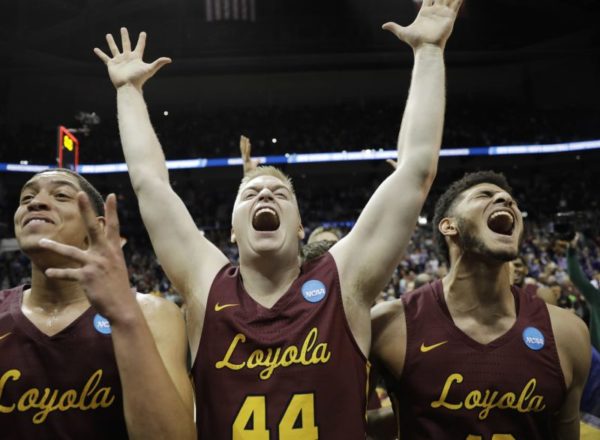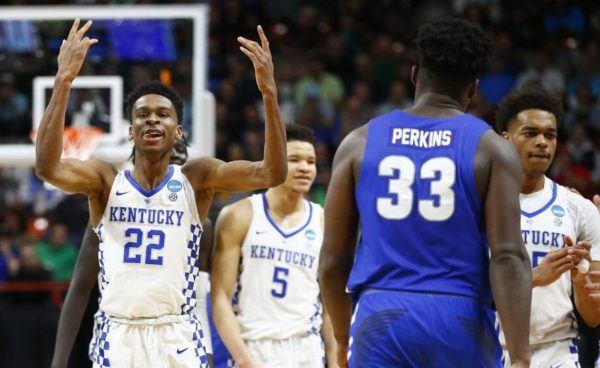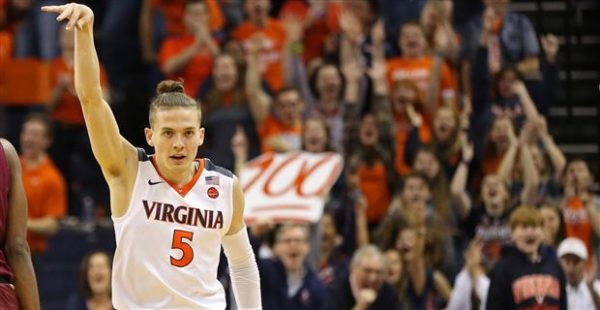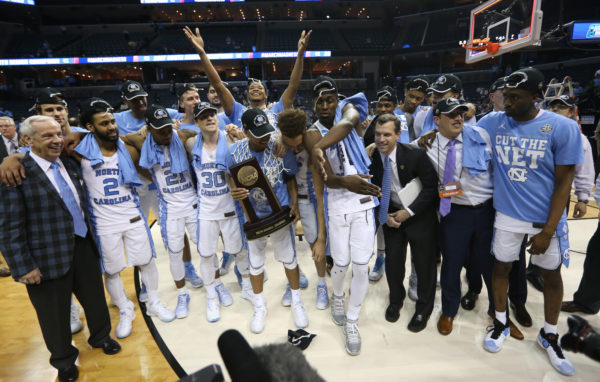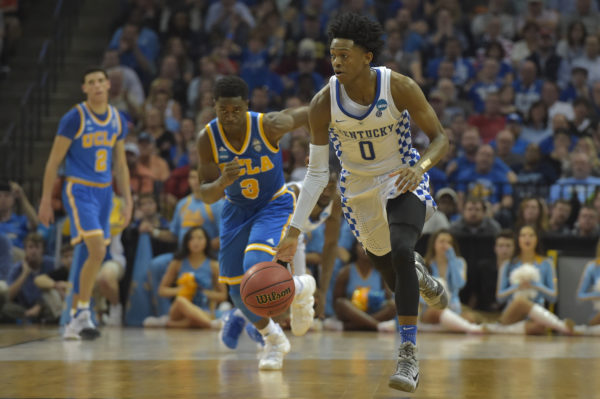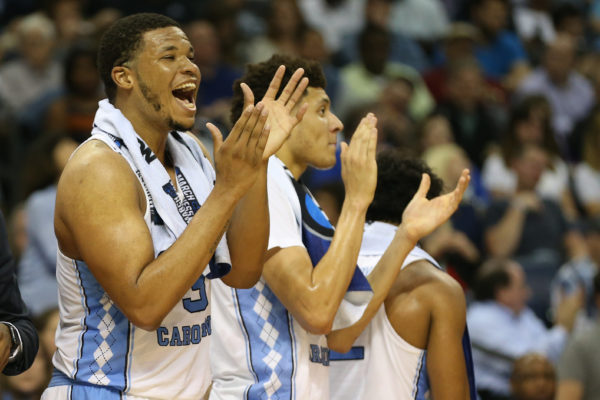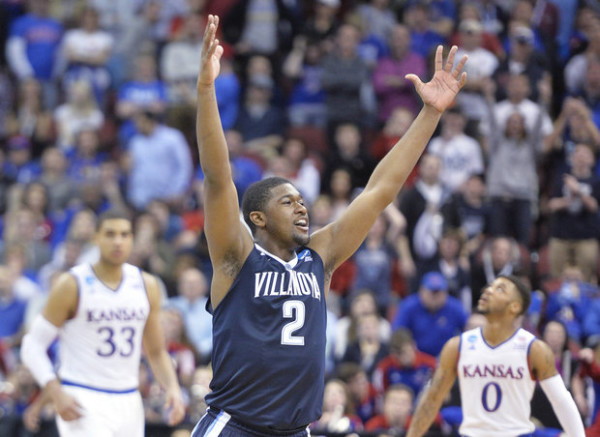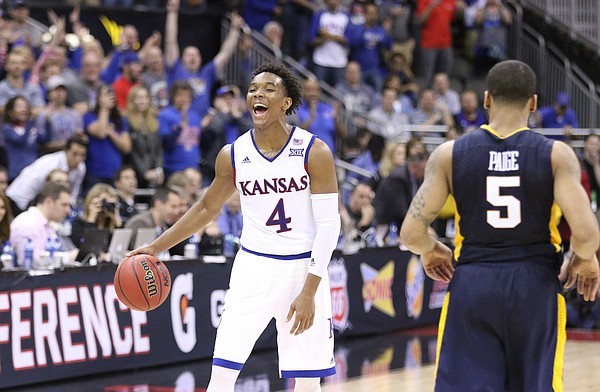Posted by Bennet Hayes on March 29th, 2015
RTC National Columnist Bennet Hayes is in Houston this week for the South Regional semifinals and final.
Three Key Takeaways.
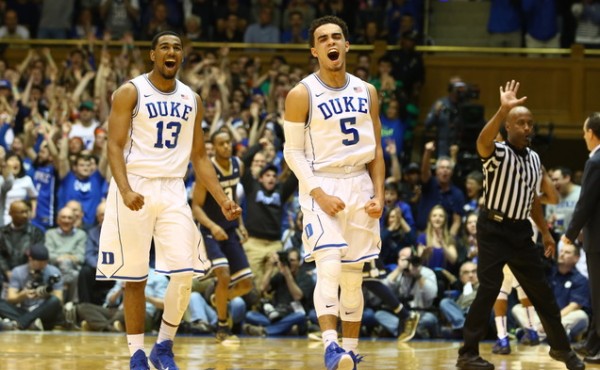
Both Jones’ — Tyus And Matt — Were Instrumental In Duke’s Elite Eight Victory Over Gonzaga (Photo: Duke Chronicle)
- Offenses Fail To Get Going, Again. In Friday night’s regional semifinals, four teams that began the night among the 65 most accurate three-point shooting teams in the country combined to shoot 23 percent from long-range. Much was made of the clumsy dome setup inducing the offensive malaise, but the forecast for Sunday was still for efficient offense by the bucket-load, given the firepower Duke and Gonzaga brought to the table. The two teams got off to a fast start – 22 points in the first five minutes – but things settled down significantly from there on out. Gonzaga and Duke combined to shoot 41 percent from the floor, including just 38 percent for the victorious Blue Devils. Duke did do two things extremely well offensively: shoot the ball accurately from three-point range (8-19) and maximize possessions (an amazing three total turnovers for the game). Gonzaga was less proficient in each category, making only two of 10 three-point attempts and turning the ball over 13 times. There were glimpses of the offensive brilliance we witnessed from both these teams all season, but this regional final never escalated into the explosive matchup many expected.
- Matt Jones, Who? Matt Jones. The Duke sophomore supplied the game of his life in this Regional Final. Jones, who entered Sunday averaging just 5.9 points per game, finished with 16 points (one shy of his season and career highs) and converted four of Duke’s eight made three-point field goals. With Quinn Cook and Tyus Jones again struggling to find the range from deep (combined 2-8 on three-point attempts), Jones’ unexpected scoring was crucial in getting the Blue Devils into the final minutes with a lead. Mark Few said afterwards that concerns about guarding Justise Winslow had led to Gonzaga to do a significant amount of cross-matching with Kyle Wiltjer defending Jones, a reasonable coaching decision that devolved into a disastrous result for the Zags. Jones, Duke’s fifth starter and a Texas native (like Friday night hero Justise Winslow) playing in his home state, was as important as any of his more acclaimed teammates Sunday afternoon.
- Wiltjer-Winslow Matchup. This was the matchup many fixated on in advance of Sunday afternoon, and with good reason: Winslow was coming off a scintillating Friday night performance, while Wiltjer has been arguably the Zags best player all season. Mixing and matching by both coaches saw both players spend a good deal of time defending elsewhere, but Wiltjer kept Gonzaga close in the first half, scoring 13 points on 5-7 field-goal shooting. Meanwhile, Winslow forced the action early and managed just five points in the opening frame, missing five of his six field-goal attempts. Things changed dramatically after intermission, however. Wiltjer struggled to get touches and was a virtual non-factor in the second half, while Duke’s freshman swingman found his Friday night form, pumping in 11 second-half points. Among the 11 was the biggest shot of the night, a three-pointer with the shot clock winding down and less than three minutes to go that put Duke up nine. Both players finished with 16 points, but Winslow’s big second-half was a key differentiator for Mike Krzyewski’s team.
Star of the Game. Tyus Jones, Duke. None of Duke’s big four – Jones, Winslow, Jahlil Okafor and Quinn Cook – played anything close to a perfect game today. Heck, they combined to shoot 15-45 from the field. Still, it was Jones that catalyzed Duke’s quick start, scoring seven points as the Blue Devils jumped out to a 17-10 lead. The South Region’s Most Outstanding Player finished the day with 15 points, six assists and no turnovers, helping Duke to that minuscule turnover total of three. Matt Jones’ unexpected scoring was a huge boost Sunday afternoon, but it was the more familiar Jones on the Duke roster who dictated this game’s flow from the outset. His ball-handling and all-around savvy will now be put to use in Indianapolis.
Quotable. “It’s meant everything. Best team I have ever been on talent-wise and the best group of guys. We can look back and be pretty happy with what we have been able to do.” –Kevin Pangos, Gonzaga senior point guard, on what this Gonzaga season has meant to him.
“It’s a shot he makes. It’s a shot he makes 499 times out of 500.” –Mark Few, on Kyle Wiltjer’s missed layup with 4:51 to go that would have tied game. Duke went on a 13-1 run to close the game after the miss.
“Our defense the last 16 minutes was spectacular — not (just) good. I love these guys and they came through.” –Mike Krzyewski, Duke head coach
“This team is eight guys. There is not someone hiding in the locker room that is going to come out and appear.” -Krzyewski.
Sights & Sounds. Whether it was the Sunday afternoon time slot, a Final Four bid on the line, or just the anticipation of the region’s top two seeds meeting, there was an urgency in NRG Stadium that never existed Friday night. The Duke faithful significantly outnumbered Gonzaga supporters (rough estimate — 5:1 ratio of Duke to Gonzaga fans), but enough folks from the Pacific Northwest made the journey South to create a back-and-forth feel to the cheering. In the end, however, the final image of NRG Stadium was all too familiar: Thousands of contented Duke fans standing in acknowledgment of a Blue Devil team advancing to face their next challenge.
What’s Next? Duke advances to the program’s 16th Final Four, where it will take on Tom Izzo and Michigan State in Indianapolis. The fourth overall meeting between Mike Krzyewski and Tom Izzo in the NCAA Tournament will double as the second time they have met in a National Semifinal. Duke has won two of those three prior matchups, which includes a Sweet 16 game two seasons ago. On the other side, the loss to Duke ends what will likely go down as the greatest season in Gonzaga history. The Zags, now 0-2 all-time in the Elite Eight, will finish the year at 35-3. Mark Few loses Byron Wesley, Gary Bell and WCC Player of the Year Kevin Pangos to graduation after an undeniably special year in Spokane.
| 2015 ncaa tournament, rushed reactions
| Tagged: byron wesley, domantas sabonis, duke, feature, final four, gary bell, gonzaga, houston, Jahlil Okafor, justise winslow, kevin pangos, kyle wiltjer, mark few, matt jones, mike krzyewski, prezemek karnowski, quinn cook, south region, Tyus Jones
Share this story
